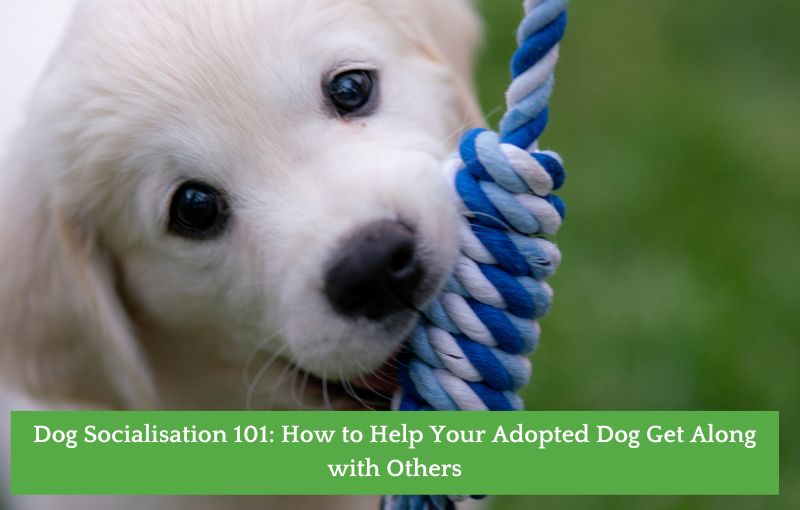
Socialising your adopted dog is one of the most important steps in helping them feel comfortable, confident, and happy in their new environment. Whether they’re meeting new people, encountering other dogs, or exploring unfamiliar surroundings, positive socialisation experiences are key to reducing fear, anxiety, and aggressive behaviours. Here’s a guide to helping your adopted dog get along with others, setting them up for a lifetime of positive interactions.
1. Start Slowly
When introducing your adopted dog to new people or animals, it’s essential to start slowly. Rushing the process can cause stress or anxiety, leading to negative experiences that may be difficult to undo. Begin by allowing your dog to observe new situations from a safe distance, letting them take in the sights, sounds, and smells at their own pace.
For the first few days after adoption, keep social interactions low-key. Avoid busy dog parks or large gatherings until your dog feels comfortable in their new home and routine.
2. Create Positive Associations
Positive reinforcement is key when socialising your adopted dog. Use treats, praise, and affection to reward calm and friendly behaviour when they meet new people or other animals. The goal is to help your dog associate new experiences with positive outcomes, making them more likely to repeat the desired behaviour.
If your dog shows signs of stress or fear—such as growling, barking, or retreating—don’t force them into the situation. Give them space to retreat and only reintroduce them when they are calm and receptive. Gradual, positive exposure is far more effective than forcing interactions.
3. Introduce New People Calmly
Some adopted dogs may be shy or anxious around unfamiliar people, especially if they have a history of neglect or limited human interaction. When introducing your dog to new people, ask them to approach slowly and avoid direct eye contact, as some dogs find this intimidating.
Encourage your dog to greet new people at their own pace, and reward them with treats when they exhibit calm behaviour. If your dog is particularly nervous, have the new person offer a treat to create a positive association.
4. Introducing Other Dogs
Introducing your adopted dog to other dogs can be a bit trickier, especially if you’re unsure of their social history. Start with calm, neutral territory such as a park or quiet street, rather than your home. Both dogs should be on a leash, and it’s a good idea to have a second person present to help manage the interaction.
Allow the dogs to sniff each other from a distance before gradually decreasing the space between them. Watch for body language cues—such as wagging tails, relaxed ears, or playful behaviour—that indicate comfort. If either dog shows signs of aggression or discomfort, separate them calmly and try again later.
5. Socialising with Other Pets
If you have other pets at home, such as cats or smaller animals, slow and careful introductions are crucial. Keep initial interactions short and supervised, and always ensure that your adopted dog has been well-exercised before meeting other animals to reduce excess energy.
Allow your other pets to observe the new dog from a distance before allowing closer interactions. Always be patient, as it may take time for your pets to adjust to the new addition. In some cases, it may take weeks or even months for pets to feel comfortable around each other, but with consistent, positive reinforcement, they’ll eventually learn to coexist.
6. Expose Your Dog to Different Environments
Socialisation isn’t just about other people and animals; it’s also about helping your dog feel comfortable in different environments. Take your adopted dog on walks through a variety of places—such as parks, quiet streets, or the beach—to expose them to new sounds, smells, and sights.
These outings provide mental stimulation, reduce fear of the unknown, and help your dog feel more confident in unfamiliar settings. Always make sure to praise and reward your dog for calm behaviour during these experiences to reinforce positive associations.
7. Use Obedience Training as a Tool
Obedience training is a fantastic way to improve your dog’s social skills. Basic commands like “sit,” “stay,” and “leave it” help you manage your dog’s behaviour in potentially stressful situations, allowing you to control interactions with other people or animals.
Obedience classes are also a great opportunity for structured socialisation, as your dog will be around other dogs in a controlled environment. These classes can help build your dog’s confidence and improve their ability to focus on you in distracting situations.
8. Be Patient and Consistent
Patience and consistency are key when socialising your adopted dog. Some dogs may take longer to adjust to new people, animals, or environments, and that’s perfectly normal. It’s important not to rush the process and to always reinforce positive behaviour with praise, treats, or play.
Remember, socialisation is an ongoing process that doesn’t stop once your dog feels comfortable in their new home. Continue to provide them with opportunities to meet new people, interact with other dogs, and explore different places throughout their life.
Helping your adopted dog become well-socialised is one of the most rewarding steps in building a strong bond and ensuring their happiness in your home. By starting slowly, creating positive associations, and providing plenty of opportunities for socialisation in a calm and controlled way, you’ll help your dog develop the confidence to thrive in any social situation. With patience, consistency, and love, your adopted dog will learn to get along with others and enjoy a life full of positive interactions.

